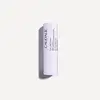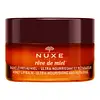What's inside
What's inside
 Key Ingredients
Key Ingredients

 Benefits
Benefits

 Concerns
Concerns

 Ingredients Side-by-side
Ingredients Side-by-side

Caprylic/Capric Triglyceride
MaskingRicinus Communis Seed Oil
MaskingCera Alba
EmollientC10-18 Triglycerides
EmollientButyrospermum Parkii Butter
Skin ConditioningMacadamia Ternifolia Seed Oil
EmollientCopernicia Cerifera Cera
EmollientHydrogenated Castor Oil
EmollientPalmitoyl Grape Seed Extract
Skin ConditioningTocopheryl Acetate
AntioxidantLimonene
PerfumingLinalool
PerfumingLeontopodium Alpinum Flower/Leaf Extract
Skin ConditioningGeraniol
PerfumingParfum
MaskingCaprylic/Capric Triglyceride, Ricinus Communis Seed Oil, Cera Alba, C10-18 Triglycerides, Butyrospermum Parkii Butter, Macadamia Ternifolia Seed Oil, Copernicia Cerifera Cera, Hydrogenated Castor Oil, Palmitoyl Grape Seed Extract, Tocopheryl Acetate, Limonene, Linalool, Leontopodium Alpinum Flower/Leaf Extract, Geraniol, Parfum
Cera Alba
EmollientHelianthus Annuus Seed Oil
EmollientButyrospermum Parkii Butter
Skin ConditioningLecithin
EmollientC10-18 Triglycerides
EmollientCaprylic/Capric Triglyceride
MaskingMel
EmollientCitrus Grandis Peel Oil
MaskingCamelina Sativa Seed Oil
Skin ConditioningOleic/Linoleic/Linolenic Polyglycerides
EmollientGlyceryl Caprylate
EmollientTocopherol
AntioxidantCitrus Limon Peel Oil
MaskingPropolis Extract
Skin ConditioningCitric Acid
BufferingCitral
PerfumingLinalool
PerfumingGeraniol
PerfumingLimonene
PerfumingCera Alba, Helianthus Annuus Seed Oil, Butyrospermum Parkii Butter, Lecithin, C10-18 Triglycerides, Caprylic/Capric Triglyceride, Mel, Citrus Grandis Peel Oil, Camelina Sativa Seed Oil, Oleic/Linoleic/Linolenic Polyglycerides, Glyceryl Caprylate, Tocopherol, Citrus Limon Peel Oil, Propolis Extract, Citric Acid, Citral, Linalool, Geraniol, Limonene
 Reviews
Reviews

Ingredients Explained
These ingredients are found in both products.
Ingredients higher up in an ingredient list are typically present in a larger amount.
This ingredient is also known as shea butter. It is an effective skin hydrator and emollient.
Emollients help soothe and soften your skin. It does this by creating a protective film on your skin. This barrier helps trap moisture and keeps your skin hydrated. Emollients may be effective at treating dry or itchy skin.
Shea butter is rich in antioxidants. Antioxidants help fight free-radicals, or molecules that may harm the body. It is also full of fatty acids including stearic acid and linoleic acid. These acids help replenish the skin and keep skin moisturized.
While Shea Butter has an SPF rating of about 3-4, it is not a sunscreen replacement.
Shea butter may not be fungal acne safe. We recommend speaking with a professional if you have any concerns.
Learn more about Butyrospermum Parkii ButterC10-18 Triglycerides is a skin conditioning and texture-enhancer.
It is created from glycerin and a mixture of C10-18 fatty acids.
This ingredient improves spreadability and helps thicken a product.
According to manufacturers, it usually comes from vegetable-based saturated fatty acids. Common bases for this ingredient are coconut oil, palm kernel oil, or both.
Due to the melting point being close to skin temperature, it is usually used in lip products.
Triglycerides are a main component of fat in the human body.
Learn more about C10-18 TriglyceridesThis ingredient is an emollient, solvent, and texture enhancer. It is considered a skin-softener by helping the skin prevent moisture loss.
It helps thicken a product's formula and makes it easier to spread by dissolving clumping compounds.
Caprylic Triglyceride is made by combining glycerin with coconut oil, forming a clear liquid.
While there is an assumption Caprylic Triglyceride can clog pores due to it being derived from coconut oil, there is no research supporting this.
Learn more about Caprylic/Capric TriglycerideCera alba is beeswax, or the wax used by bees to make honeycombs. It is a texture-enhancer and emollient. A study from 2003 found beeswax to be a stronger emollient than ingredients such as petroleum jelly.
As an emollient, beeswax helps hydrate the skin by creating a barrier on top. This barrier traps moisture in.
Emulsifiers help prevent ingredients from separating. This helps create consistent texture.
The structure of beeswax is mainly long-chain alcohols and the esters of fatty acids.
There are three types of beeswax: yellow, white, and absolute. Yellow is pure beeswax taken from the honeycomb. White beeswax is created by filtering or bleaching yellow beeswax. Absolute beeswax is created by treating beeswax with alcohol. Beeswax used in cosmetics are purified.
Beeswax has been used throughout history and even in prehistoric times. Some common uses for beeswax still used today are making candles, as a waterproofing agent, and polish for leather.
Learn more about Cera AlbaGeraniol is used to add fragrance/parfum to a product. It is the main component of citronellol. It is a monoterpenoid and an alcohol.
Monoterpenes are naturally found in many parts of different plants.
Geraniol can be found in many essential oils including Rose Oil and Citronella Oil. The scent of Geraniol is often described as "rose-like". Many foods also contain Geraniol for fruit flavoring.
Geraniol can irritate the skin when exposed to air. However, irritation depends on the ability of geraniol to penetrate into the skin. In general, geraniol is not able to penetrate skin easily.
Geraniol is colorless and has low water-solubility. However, it is soluble in common organic solvents.
Like citronellol, it is a natural insect repellent.
2,6-Octadien-1-ol, 3,7-dimethyl-, (2E)-
Learn more about GeraniolLimonene is a fragrance that adds scent and taste to a formulation.
It's found in the peel oil of citrus fruits and other plants such as lavender and eucalyptus. The scent of limonene is generally described as "sweet citrus".
Limonene acts as an antioxidant, meaning it helps neutralize free radicals.
When exposed to air, oxidized limonene may sensitize the skin. Because of this, limonene is often avoided by people with sensitive skin.
The term 'fragrance' is not regulated in many countries. In many cases, it is up to the brand to define this term. For instance, many brands choose to label themselves as "fragrance-free" because they are not using synthetic fragrances. However, their products may still contain ingredients such as essential oils that are considered a fragrance.
Learn more about LimoneneLinalool is a fragrance and helps add scent to products. It's derived from common plants such as cinnamon, mint, citrus, and lavender.
Like Limonene, this ingredient oxidizes when exposed to air. Oxidized linalool can cause allergies and skin sensitivity.
This ingredient has a scent that is floral, spicy tropical, and citrus-like.
Learn more about Linalool